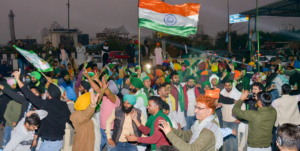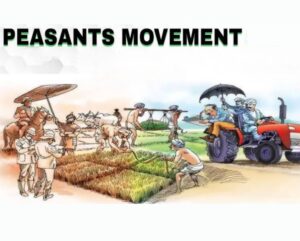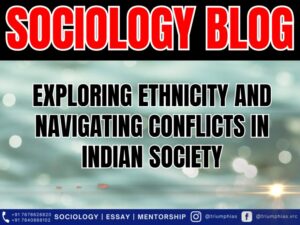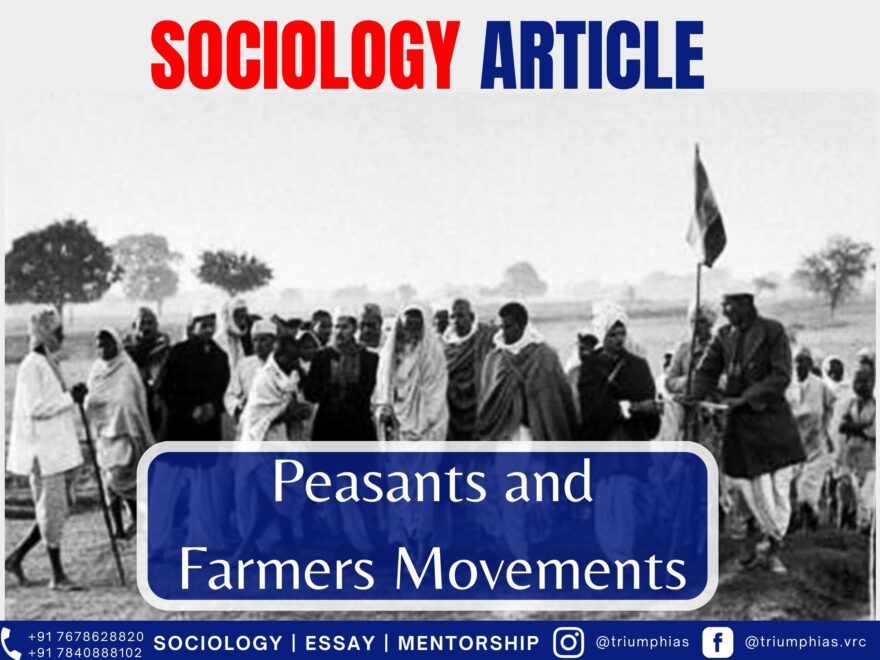Peasants and Farmers Movements
Relevant for Sociology Optional for Civil Service Examination.
Paper 2: Unit-13 Social change in India; Social Movements in modern India

Peasants and Farmers Movements.
Understanding Social Movements
Social movements are more than spontaneous, unorganized protests or acts of dissent. They require sustained, collective action that is driven by shared objectives and ideologies, aiming to promote or resist change in society. Here’s a simplified breakdown:
A social movement involves continuous collective efforts over a period, unlike isolated protests which are temporary.
Typically, social movements are aimed at challenging or changing state policies or societal norms.
A certain level of organization, including leadership and structural planning, characterizes these movements.
Participants in a social movement share common goals and ways to approach and facilitate or prevent societal changes.
Throughout its existence, the characteristics defining a social movement may evolve.
Social movements aim to address and modify public issues, facing opposition or counter-movements that defend the existing societal status quo. For example, in history, movements that advocated for women’s education, abolition of sati, or lower caste rights faced significant backlash and resistance.
Understanding the link between social movements and societal changes:
It’s crucial to differentiate between general societal changes and social movements. Societal change is a constant process influenced by cumulative individual and collective actions, while social movements target specific goals, driven by prolonged collective effort.
Social movements in India have varied in nature, from protests and dissent to reform, religious movements, and freedom struggles. Their emergence and style are influenced by societal structures and ideologies present at the time, and their aim is either to promote or resist societal change.
Remember that changing society through social movements is challenging due to the resistance they face against established interests and values. However, with time, social movements do contribute to significant societal transformations.
Orientation of Social Movements:
Before the British era, social movements in India mainly focused on religious issues. However, during British rule, movements also began aiming at national liberation against colonialism and imperialism, especially after the 1930s. Post-independence, movements started targeting various issues like political authority, economic exploitation, cultural and male domination, and women’s humiliation, leading to a rise in various types of movements.
Classification of Social Movements:
Social movements can be classified based on several factors such as:
Nature of Change: Movements are categorized based on their goals and the kind of change they intend to bring, like tribal, Harijan, women’s, peasant, student, and industrial workers’ movements. They can also be classified based on opposition like anti-Brahminism, anti-leftist, and anti-Dalits.
Territorial Focus: Some movements are named after the regions they originate from or operate in, like the Vidharbha, Telangana, and Uttaranchal movements. The names often reflect their objectives.
Issues and Leadership: Movements can be named after specific issues they focus on like anti-corruption or after the leaders who initiate them like the Gandhian movement.
Key Characteristics of Movements:
Social movements generally possess certain common characteristics such as a collective goal, a shared ideology or program, collective actions, and a basic level of organization and leadership. Unlike ‘agitations’, social movements have a defined ideology and organization.
Different Perspectives:
Scholars have various views on social movements. For instance, Ghanshyam Shah sees some collective actions, termed ‘agitations’ by some, as movements, citing demands for the formation of linguistic states as examples. Other scholars believe that some movements arise due to the constitution’s inability to safeguard people’s civil and democratic rights or due to the state’s failure in societal transformation, leading to public struggles.
Theoretical Views:
Some theorists, like Gurr and Rao, explain social movements from a ‘relative deprivation’ perspective, focusing on the possibility of action by the suffering parties. However, Shah and Oommen criticize this approach, arguing that it doesn’t sufficiently consider the ongoing processes of change, the sources of deprivation, or the participants’ consciousness and ideological aspects.
Peasant and Farmers Movements
Researching peasant movements has become crucial in understanding social movements in India due to the country’s agricultural essence. A significant focus is on agrarian issues in sociological studies due to this.
Agrarian Structure: Different patterns of landownership and usage reveal a complicated agrarian structure, influenced by diverse land systems and agrarian relations. Daniel Thorner categorized the agrarian classes into three: Maliks (big landlords), Kisans (small landowners and tenant farmers), and Mazdoors (landless laborers or those working on others’ lands). These classes vary regionally and reflect the complexity of India’s rural reality.
Relation with Caste: The agrarian hierarchy often aligns with caste hierarchies. Rich landowners usually belong to upper castes, middle and small peasants to traditional peasant castes, and landless laborers to lower castes. This general pattern helps to understand rural dynamics but isn’t universally applicable.
Nature of Movements: Different peasant classes have initiated various movements, as studied by D.N. Dhanagare. He stated that ‘peasant movements’ include various collective efforts by peasants aiming for systemic change or specific grievance redressals. These movements could be violent or non-violent and have diverse organizational structures.
Issues in Peasant Movements:

Types of Conflicts: Movements often stemmed from conflicts between tenants and landlords, oppressions by majority religious communities, and other socio-economic factors.
Influence of National Leaders: Some scholars argue that leaders like Gandhi mobilized peasants more for national freedom rather than against specific oppressions by landlords.
Post-Independence Changes: After independence, leaders focused more on rallying peasants against landlords. However, the unity among peasants was lacking due to various internal alignments and divisions. Over time, with heightened sentiments against landlords, some peasants transformed into a significant revolutionary force, although this wasn’t consistent across all regions of India.
Six Perspectives on Agrarian Movements in India:
Functional View: Movements have been studied for their operation at grassroot levels.
Political Association: The relationship between politics and agrarian movements, like the involvement of political parties such as Congress and the communists in mobilizing peasants.
Social Structure: Exploration of the link between social structures like caste, class, power, and agrarian movements.
Impact of Green Revolution: Studying the connection between the green revolution and movements, focusing on its influence on traditional relations, economic disparities, and the changing aspirations of villagers.
Legislation and Movements: Examining the interplay between agrarian laws and movements, including how movements can influence or be influenced by legislation.
Mobilization and Organization: Some movements, like the Bhoodan movement by Vinoba Bhave and Sarvodya movement by Jayaprakash Narayan, were organized focusing on Gandhian principles but didn’t fully accomplish their goals.
Historical Overview of Peasant Movements:
19th Century Movements: India has a rich history of peasant movements, with notable instances of rebellion against landlords and other authority figures, such as the Indigo Revolt in Bengal.
Connection to Freedom Struggle: Peasant grievances also became integrated into India’s freedom movement, such as in movements led by Mahatma Gandhi, which also fostered political awareness among the masses.
Regional Movements: Different regions saw the formation of peasant organizations and movements aimed against economic exploitation, like the Bihar Provincial Kisan Sabha and the All India Kisan Sabha.
Post-Independence Era:
Transition of Focus: The focus of movements transitioned post-independence, reflecting new societal changes and policies like land reforms and the zamindari abolition.
Prominent Movements: Notable movements after 1947 included the Naxalite struggle and new farmers’ movements, indicating the continued role of social movements in societal change and adjustment. These movements had different degrees of success but were instrumental in shaping agrarian reforms post-independence.
Tebhaga Movement (1946-47): Several factors influenced this movement, such as the 1943 famine, action against powerful landlords and corrupt marketers, unity among the tribals involved, and improved negotiation power of the share-croppers. However, the movement didn’t succeed due to its limited reach, communal politics, and manipulation by the upper classes.
Telangana Movement (1946-52): This was against the feudal abuse by rulers and local landlords in Andhra Pradesh. Powerful landlords, often from upper castes or influential communities, exerted excessive economic pressure and forced labor on the poor. Organizations like the Indian National Congress and Andhra Maha Sabha had been addressing peasant issues since the 1920s, advocating for better conditions and against oppressive systems. With India’s independence in 1947, the movement intensified, advocating for major social changes and pushing against the local rulers and their oppressive systems.
Naxalbari Movement: Started in West Bengal in 1967, this movement, led by figures like Charu Majumdar and Kanu Sanyal, focused on increasing militant actions among peasants and preparing them for armed conflict. It began with a focus on mass participation and the forceful claiming of land but evolved towards more secretive, small-group guerrilla actions. This led to revolts, notably in areas like Naxalbari, where peasants, facing extreme exploitation, were led in demands for better conditions and rights. The movement’s strategies included seizing lands from powerful landlords and pushing for the rights and produce of the cultivated lands to be given to the peasants.
Characteristics of the Naxalbari Uprising in West Bengal:
The movement focused on defending the rights of peasants and laborers, including all ethnicities and castes.
It operated outside formal institutions and encouraged violent actions.
Communist party leaders spearheaded the movement.
It aimed to reduce the power of wealthy landlords (jotedars) and uplift peasants and laborers. Unlike the Sarvodya movement, which promoted communal land ownership, the Naxalbari movement sought individual ownership.
Reasons for the Movement’s Failure:
The movement’s alignment with China and rejection of Indian national leadership.
Its declared goal was to take over state power, and it openly supported violence and internal conflicts within leftist groups.
Critics, like R.K. Mukherjee, believed the movement aimed not against the system but its abuses, seeking fairer exchanges between peasants and landlords.
New Farmers’ Movements since the 1970s:
Started in regions like Punjab and Tamil Nadu, these non-party movements involved farmers, focusing on issues like subsidies, taxes, and loan repayments.
The movements also adopted new protest methods like blocking roads and restricting politicians’ access to villages. They expanded their focus to include environmental and women’s issues.
General Nature of Peasant Movements:
These movements, seen as social and cultural, primarily began after India’s independence.
Some scholars, like Moore Junior, argue that Indian peasants have traditionally been passive, resulting in limited cultivation advances and minimal movements.
However, this view is contested by others like A.R. Desai and D.N. Dhanagare, who highlight the numerous overlooked peasant revolts throughout history, challenging the generalizations made by Moore.
Classification of Peasant Movements:
A.R. Desai and Ghanshyam Shah have organized peasant movements in India based on different time periods—before British rule, after independence, and further categorized within the post-independence era (before and after the Naxalite movements and the Green Revolution). Additionally, they divided it based on the Emergency period.
A.R. Desai believes that the nature of peasant movements has been influenced by the changes in agrarian structures over different periods. He categorizes colonial India into areas based on different land revenue systems like ryotwari, zamindari, and tribal zones, which each had unique peasant struggles due to their distinct issues and societal levels involved.
In post-independence India, Desai also divides agrarian struggles into two groups: those led by wealthy farmers and those by poor farmers. He suggests that there hasn’t been a consistent pattern of agrarian structure across the country.
Kathleen Gough has classified peasant uprisings based on their objectives, ideologies, and organizational methods into five categories:
Movements aimed at removing the British and reinstating previous rulers,
Movements driven by religious motivations,
Acts of social rebellion or banditry,
Acts of terrorism aiming for collective justice, and
Large-scale uprisings aiming to address specific grievances.
Reference: Static Portion
Related Blogs…
 |
 |
Frequently Asked Questions:
1. Question: Define the term “ethnic movement” and provide an example from India.
Answer: An ethnic movement refers to a collective effort by a group sharing common cultural, linguistic, or religious traits, seeking to assert their identity and rights; an example from India is the Khalistan Movement in Punjab.
2. Question: Identify the main objectives behind the Gorkhaland ethnic movement.
Answer: The Gorkhaland ethnic movement primarily seeks to establish a separate state for India’s Nepali-speaking population in the Darjeeling region, advocating for linguistic and cultural recognition and political autonomy.
3. Question: What was the Operation Blue Star, and which ethnic movement was it related to?
Answer: Operation Blue Star was a military action in 1984, aiming to remove Sikh militants hiding in the Golden Temple in Amritsar; it is related to the Khalistan movement, which sought a separate Sikh country.
4. Question: Mention a critical factor that triggered the emergence of ethnic movements in India, as discussed by Dipankar Gupta.
Answer: Dipankar Gupta emphasized that ethnicity is fundamentally a political process, wherein caste and religion, the key components of identity formation, are politicized by leaders for vested interests.
5. Question: What were the primary reasons for the Assam Ethnicity conflicts involving Bodo tribals and Bengali Muslim settlers?
Answer: The Assam Ethnicity conflicts primarily stemmed from issues related to immigration, land rights, and resource allocation, leading to clashes, riots, and evolving relationships among indigenous communities to address challenges.
6. Question: Briefly describe the role of the Dravidian Movement in terms of caste and societal structure.
Answer: The Dravidian Movement, led notably by E.V. Ramasamy, aimed to establish an egalitarian society, focusing on anti-Brahmanism and advocating for equal rights for backward castes, while also introducing reforms like self-respect marriages.
7. Question: Name the prominent ethnic movements in North-East India and specify one common objective.
Answer: Prominent ethnic movements in North-East India include the Nagas’ and Mizos’ struggles; a common objective was to gain autonomy and recognition for their distinct tribal identities and cultural uniqueness.
8. Question: What is the key argument of Gail Omveldt regarding traditional Indian society and multiculturalism?
Answer: Gail Omveldt opposed romanticizing traditional Indian society, arguing that hierarchy has always dominated it and dismissing the notion that multiculturalism is an intrinsic feature of Indian society as a myth.
9. Question: Briefly explain the social hierarchy factor as a contributing element to ethnic movements as suggested by Olzak.
Answer: Olzak suggests that the construction of hierarchies among ethnic communities, which often leads to the suppression of one group by another, is a key factor that can instigate social and ethnic movements.
10. Question: Identify one consequence of the unequal economic development factor within the context of ethnic movements in India.
Answer: One consequence of unequal economic development is the marginalization and underdevelopment of certain groups, leading to feelings of alienation and sometimes initiating ethnic movements as these groups strive for equality and recognition.
GS Related Practices Questions…
To master these intricacies and fare well in the Sociology Optional Syllabus, aspiring sociologists might benefit from guidance by the Best Sociology Optional Teacher and participation in the Best Sociology Optional Coaching. These avenues provide comprehensive assistance, ensuring a solid understanding of sociology’s diverse methodologies and techniques.
META TAGS:
Ethnic Movements, ethnic movements in india, ethnic movement in sociology, Punjab Movement, North-East Ethnic Movements, Gorkhaland Movement, Dravidian Movement, Assam Ethnicity, Ethnic Conflicts, Sociopolitical Impact, India, Ethnic Consciousness, Ethnic Rights, Political Crisis, Economic Development, Cultural Disparities, Khalistan Movement, Nagaland, Mizoram, Multiculturalism, Political Economy, Identity Formation, Social Hierarchies, Bodo Tribals, Bengali Muslim Settlers, Anti-Sikh Riots, Operation Blue Star, Unequal Development, Ethnic Violence, Political Mobilization

Why Vikash Ranjan’s Classes for Sociology?
Proper guidance and assistance are required to learn the skill of interlinking current happenings with the conventional topics. VIKASH RANJAN SIR at TRIUMPH IAS guides students according to the Recent Trends of UPSC, making him the Best Sociology Teacher for Sociology Optional UPSC.
At Triumph IAS, the Best Sociology Optional Coaching platform, we not only provide the best study material and applied classes for Sociology for IAS but also conduct regular assignments and class tests to assess candidates’ writing skills and understanding of the subject.
Choose The Best Sociology Optional Teacher for IAS Preparation?
At the beginning of the journey for Civil Services Examination preparation, many students face a pivotal decision – selecting their optional subject. Questions such as “which optional subject is the best?” and “which optional subject is the most scoring?” frequently come to mind. Choosing the right optional subject, like choosing the best sociology optional teacher, is a subjective yet vital step that requires a thoughtful decision based on facts. A misstep in this crucial decision can indeed prove disastrous.
Ever since the exam pattern was revamped in 2013, the UPSC has eliminated the need for a second optional subject. Now, candidates have to choose only one optional subject for the UPSC Mains, which has two papers of 250 marks each. One of the compelling choices for many has been the sociology optional. However, it’s strongly advised to decide on your optional subject for mains well ahead of time to get sufficient time to complete the syllabus. After all, most students score similarly in General Studies Papers; it’s the score in the optional subject & essay that contributes significantly to the final selection.
“A sound strategy does not rely solely on the popular
Opinion of toppers or famous YouTubers cum teachers.”
It requires understanding one’s ability, interest, and the relevance of the subject, not just for the exam but also for life in general. Hence, when selecting the best sociology teacher, one must consider the usefulness of sociology optional coaching in General Studies, Essay, and Personality Test.
The choice of the optional subject should be based on objective criteria, such as the nature, scope, and size of the syllabus, uniformity and stability in the question pattern, relevance of the syllabic content in daily life in society, and the availability of study material and guidance. For example, choosing the best sociology optional coaching can ensure access to top-quality study materials and experienced teachers. Always remember, the approach of the UPSC optional subject differs from your academic studies of subjects. Therefore, before settling for sociology optional, you need to analyze the syllabus, previous years’ pattern, subject requirements (be it ideal, visionary, numerical, conceptual theoretical), and your comfort level with the subject.
This decision marks a critical point in your UPSC – CSE journey, potentially determining your success in a career in IAS/Civil Services. Therefore, it’s crucial to choose wisely, whether it’s the optional subject or the best sociology optional teacher. Always base your decision on accurate facts, and never let your emotional biases guide your choices. After all, the search for the best sociology optional coaching is about finding the perfect fit for your unique academic needs and aspirations.
To master these intricacies and fare well in the Sociology Optional Syllabus, aspiring sociologists might benefit from guidance by the Best Sociology Optional Teacher and participation in the Best Sociology Optional Coaching. These avenues provide comprehensive assistance, ensuring a solid understanding of sociology’s diverse methodologies and techniques. Sociology, Social theory, Best Sociology Optional Teacher, Best Sociology Optional Coaching, Sociology Optional Syllabus.
Best Sociology Optional Teacher, Sociology Syllabus, Sociology Optional, Sociology Optional Coaching, Best Sociology Optional Coaching, Best Sociology Teacher, Sociology Course, Sociology Teacher, Sociology Foundation, Sociology Foundation Course, Sociology Optional UPSC, Sociology for IAS,
Follow us :
🔎 https://www.instagram.com/triumphias
🔎https://www.youtube.com/c/TriumphIAS
🔎https://t.me/VikashRanjanSociology
Find More Blogs…
| Compare and contrast Karl Marx’s and Max weber’s | Karl Marx- Historical Materialism |
| Talcott Parsons : Social system | Scope of the subject and comparison with other social sciences |
KEYWORD: Peasants and Farmers Movements, Peasants and Farmers Movements, Peasants and Farmers Movements, Peasants and Farmers Movements, Peasants and Farmers Movements, Peasants and Farmers Movements, Peasants and Farmers Movements, Peasants and Farmers Movements, Peasants and Farmers Movements, Peasants and Farmers Movements, Peasants and Farmers Movements, Peasants and Farmers Movements, Peasants and Farmers Movements, Peasants and Farmers Movements, Peasants and Farmers Movements, Peasants and Farmers Movements, Peasants and Farmers Movements, Peasants and Farmers Movements, Peasants and Farmers Movements, Peasants and Farmers Movements, Peasants and Farmers Movements, Peasants and Farmers Movements


